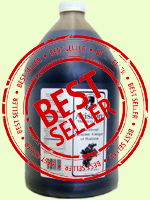More like wine than vinegar, genuine balsamico gets complex flavor from lengthy aging in lots of wood
by Paul Bertolli
“Aged balsamic vinegar tastes like time itself,” says Paul Bertolli.
Everyone who loves to eat has experienced a private moment of awe over some particular food or drink. Such moments refuse description—it’s impossible to reduce to words a perfectly ripe pear, the luscious synthesis of a slow-cooked braise, or vintage wine that has found its way to fullness. We’re first riveted by the utter singularity of what we sense; then we’re caught up in a complex architecture of taste. We praise the gardener, cook, or winemaker, and rightly so, but what caused our reaction can really only occur at the hands of nature, under the sealed lid of the braising pot, or by the secret alchemy of time.
The first time I tasted real aged balsamic vinegar, I felt awe. I was asked to extend my hand to form a well between my thumb and wrist. Into this crevice my host poured several heavy drops of a dark, shiny syrup as thick as molasses from a small, heavy flask. What began as a simple contrast between sweet and sour deepened into penetrating layers of flavor that mingled the aromas of wood and cooked fruit, harmoniously balanced on a taut line of acidity. From there it moved into a more evocative dimension that sent me on a goose-chase for descriptors—cedar chest, dried fruit, stewed cherries, tobacco, but also something more mysterious and hard to describe, for aged balsamic vinegar tastes of time itself.
Not everything labeled balsamic vinegar is the real thing
Before it was introduced to the American market in the late 1970s, balsamic vinegar was known only to those who might have had the chance to hear of it or taste it on their travels through the Italian cities of Modena or Reggio Emilia and the surrounding countryside. Balsamic vinegar’s roots go back to antiquity. In the Emila-Romagna, it remained a guarded family tradition that existed well outside of commerce. Today there’s hardly a supermarket that doesn’t carry on its shelves at least half a dozen brands of balsamic vinegar in a confusing variety of shapes, sizes, prices, and claims of vintage. Because there are no U.S. standards of identity for balsamic vinegar, both the imported and domestically produced ones vary widely in their approximation of the real thing.
Balsamic vinegar in the kitchen
My friends in Italy have taught me how to think about balsamic vinegar in the kitchen. Cooks and devotees use both condimento and tradizionale, and they often speak of three general weights of vinegar: young (three to five years old), middle-aged (six to twelve years old), and the very old (twelve years and up, sometimes as old as 150 years). For suggestions on using the different kinds, see Balsamic vinegar is best used simply. Balsamic vinegar is always a blend of the new and the old; vintage designation does not apply to balsamic vinegar the way it does to wine. If a year is marked on the bottle, it refers to the year that the barrel battery was started.
Balsamic vinegar is best used simply
High-quality balsamic vinegar, whether young or old, is best enjoyed simply. Here are some ways to try it.
• Whisk young balsamic vinegar with shallots, extra-virgin olive oil, salt, and pepper. Toss the vinaigrette with a salad of radicchio, frisée, arugula, dandelion greens, crisped pancetta, and toasted walnuts; top with thin shards of aged Parmesan.
• Spoon old balsamic vinegar over pears baked in simple syrup and accompanied by a dollop of fresh sheep’s milk ricotta cheese.
• Drizzle a teaspoon of extra-old balsamico over aged beef tenderloin that has been seasoned with salt and pepper and seared in a cast-iron skillet.
• Drizzle middle-aged balsamic vinegar over risotto made with leeks, white wine, turkey stock, and Parmesan just before serving.
Italians call young balsamic vinegar with pronounced acidity da insalata—vinegar to be used with oil as a salad dressing; or for pinzimonio, a vinaigrette used as a dipping sauce for raw vegetables. Each diner improvises his own pinzimonio from cruets of balsamic vinegar, olive oil, salt, and pepper in the middle of the table. Young balsamic vinegar is also used to spike pan sauces and marinades.
Middle-aged balsamic vinegar is a more viscous vinegar. Italians call it medio-corpo, and this medium-bodied vinegar is used to add finesse to sauces and braises at the end of cooking, to give dimension to risotti and pasta dishes, and to enhance mayonnaise and other sauces.
Very old vinegar is called extra-vecchio, and affectionately, il patriarca. It possesses flavors, texture, and complexity that only very long aging can confer. Extra-vecchio ennobles just about any food deserving of its company. It would be a waste to mix very old balsamic vinegar with other ingredients or to pair it with highly spiced foods or complicated flavors. Its sapid perfume is best released on warm or at least room-temperature foods. It stands best alone and reveals its full potential used sparingly on unadorned prime cuts of beef, fish, poultry, or veal. It’s delicious on sautéed liver — foie gras and old balsamico is a glorious combination; still, you won’t be disappointed if you substitute fresh calf’s liver or even duck or chicken. Unmarinated wild game is particularly well suited to a few drops of old balsamic vinegar — loin of fresh venison, pigeon roasted pink. So is wild duck, as well as choice cuts of fish such as tuna, halibut, or sole. Certain fruits in their prime of ripeness deserve balsamic vinegar’s benediction — pears, wild strawberries, and peaches are exquisite, as are mild, creamy cheeses such as fresh ricotta. Perhaps the best way to enjoy old balsamic vinegar is to pour yourself a thimble glass full after dinner and savor it all by itself.
Source: http://www.finecooking.com/articles/balsamic-vinegar-famed-elixir.aspx
 Shopping Cart
Shopping Cart
